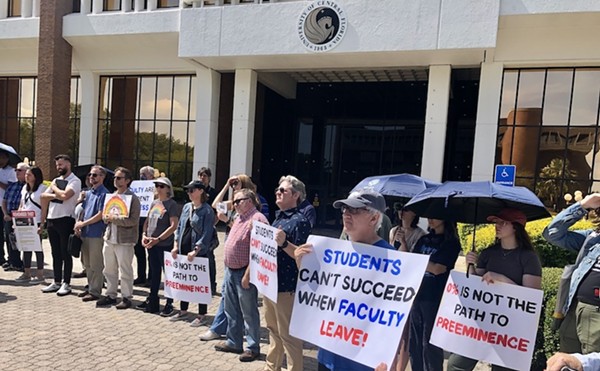At the end of the fishing dock that rests on the south end of Lake Apopka, a man leans against a wooden railing and stares at the broad expanse of water before him.
"I have been here for over 60 years," says the man, an auto mechanic whose name, Lend, is sewn onto his work shirt. "I went to all the fishing camps when I was a little boy. This lake was filled with fisherman, in and around it."
Not anymore.
"Look at it now - not a soul. It looks like pea soup," he says.
That's because, despite environmental restoration efforts in place for more than a decade, the lake - Florida's fourth largest - is still seriously polluted. For more than 40 years beginning in the 1940s, runoff from acres of so-called muck farms - vegetable farms that sprung up in marshlands around the lake that were drained so farmers could access their rich, black soil - that used to line the lake's shores washed chemicals and nutrients into the waters.
The pollution got so bad that by the mid-1990s, when the state bought up 15,000 acres of farmland around it, Lake Apopka was known as the most polluted lake in the state. Game fish populations in Lake Apopka, once known for its trophy-sized bass and fish camps, had declined significantly. In 1999, sudden large-scale bird deaths were reported around the lake, which caused an investigation by the U.S. Department of Fish and Wildlife (which eventually determined that levels of pesticides in the environment were to blame). Alligators living in the lake were found to have reproductive abnormalities and growth defects.
The health of Lake Apopka's wildlife and water have long drawn the attention of research scientists, environmentalists and citizen activists who've gone to great pains to restore the ecosystems in and around the lake.
But the ecosystem, Apopka residents say, wasn't the only thing affected by the pollution. Hundreds of farmworkers who earned their livelihoods picking and packing vegetables on those muck farms came into regular contact with toxic pesticides as well. For more than a decade, they've been trying to get someone to take their claims of health problems related to pesticide exposure seriously. Though the U.S. Department of Fish and Wildlife, the Environmental Protection Agency and others have been more than happy to study gators and birds, few have invested time or money in studying the impact of the chemicals on people.
More than 20 years ago, Linda Lee spent her days cutting vegetables in the black dirt of the farm fields around Lake Apopka and packaging them for distribution to market.
Working on the vegetable farms was a way of life for Lee's family, and she remembers spending time playing in the fields as a child while the adults labored. When she was old enough, she got her first job in the same fields where her mother worked.
Picking vegetables in the hot sun was backbreaking work - from sunrise to sunset, Lee stood alongside other farmworkers stooped at the waist, picking cauliflower, tomatoes, cabbage and corn and packing the produce into crates.
Over the course of two decades, Lee says she worked on eight different farms in the Apopka area. Though it was not an easy job, she was able to make an honest living at it, just as thousands of other residents of Apopka did during the picking seasons.
But in 1989, when she was only in her 30s, Lee started feeling ill: Her body ached, and she was often exhausted. She complained of soreness with every move and had difficulty getting around. When she took a bad spill in her driveway, she thought she'd better see a doctor. The owner of the farm she was working on agreed to foot the bill for the visit and chose a physician for her to see; that doctor blamed Lee's health problems on the fact that she was overweight and suggested that she could also, perhaps, have the flu.
"I was pretty sure that this couldn't be the reason why I was feeling like this," says Lee, who is now 58. But she didn't have the money for extensive medical testing, so she put up with it. The pain persisted, and it soon became obvious to Lee that the illness wasn't going to go away on its own, so she decided to see a new doctor - one that wasn't paid by her employer. The new doctor diagnosed her with lupus, an autoimmune disease that attacks the skin, joints and organs.
The disease is something of an enigma to the medical world. As an ailment, it affects so many body systems and its symptoms mimic so many other illnesses that it often goes undiagnosed. As a result, it's difficult to nail down figures to determine how many people actually have the disease.
But in Apopka, people close to the farm-worker community say an inordinate number of people who've worked on the muck farms picking vegetables seem to have it. Lee and others suspect it's somehow tied to the fact that nearly everyone who worked on muck farms in Apopka was regularly exposed to toxic chemicals sprayed on crops.
"There are a lot of people with lupus in our area," Lee says, estimating that about half the people she knows seem to have it - or, if they don't actually know they have it, she says, they have worrisome symptoms that make them think they could have it. "A lot of ladies that I know got similar things to what I have. They always ask me what it feels like to have lupus."

Geraldean Matthew knows that she has it. Matthew picked vegetables on muck farms for 30 years before she got sick from lupus in the 1990s and eventually had to quit. She says she remembers working in the fields while crop dusters flew overhead, dusting everything - including the people - with strong chemicals that you could smell on your skin at the end of the work day.
Matthew, 61, has two daughters who often accompanied her in the fields when they were children. Both of them have been diagnosed with lupus, too. One of her daughters discovered she had the illness when she was pregnant.
"She was just sick, sick, sick," Matthew says. "She was trying to have a baby, and she had had several miscarriages."
For years, Lee and Matthew say, they saw friends, family and neighbors who worked in the fields stricken with serious illness. "Around us, people were dying of cancer, diabetes, heart attacks, lupus," Lee says. "It felt like it was funeral after funeral."
Though they have no proof, aside from anecdotal evidence (and, some might say, coincidence), both women believe the illnesses - including the ubiquitous lupus - can be traced back to exposure to the same deadly pesticides that have been proven to be injurious to wildlife.
And they aren't alone in that suspicion. Jeannie Economos, pesticide health and safety coordinator for the Farmworker Association of Florida, which is based in Apopka, says many of the farmworkers her organization works with have developed the disease. Even more people, Economos says, exhibit symptoms.
"We feel that there is a high incidence of lupus in the community and that there might be undiagnosed cases of lupus, possibly related to the many cases of arthritis that people are experiencing," she says. But Economos says that little has been done to study health in the farmworker community, and the organizations that advocate for the farmworkers - such as FAF, which operates five outreach offices around the state on a budget of less than $1 million, per its nonprofit tax filings with the IRS - aren't equipped to do such a study themselves. "We do not have the resources to conduct any kind of specific study to determine the number of cases and how that compares to national standards," Economos says.
As a result, Lee says, the farmworkers are lost in a "chemical soup": Without evidence that they've been hurt by pesticides, no one will study their health problems; but without anyone studying their health problems, they can't show evidence that pesticides are what has hurt them.
Although medical professionals suspect a higher likelihood of lupus occurring in a person who is in direct contact with pesticides, and studies show that pesticides could have some relationship to the development of lupus, there is no conclusive evidence that supports it.
In 2006, FAF did manage to come up with funds for a modest health survey of farmworkers in Apopka. With assistance from the Presbyterian Committee on the Self-Development of People and the EPA, it embarked on the Lake Apopka Farmworkers Environmental Health Project, which interviewed 148 former farmworkers about their exposure to pesticides on the job and their ensuing health problems.
"Efforts over the years to encourage local, state and federal agencies to undertake a health assessment and/or study of the Lake Apopka farmworker community met with no response or action," the report's introduction notes. "Yet, the community continued to recount stories of debilitating illnesses and even death among their members. While research into the impacts on wildlife on Lake Apopka were ongoing, human health problems, especially that of former Lake Apopka farmworkers, were summarily ignored."

The report determined that 92 percent of those interviewed were exposed to pesticides in the workplace, mostly by touching plants wet with pesticides, being sprayed by pesticides rained down by crop dusters and inhaling drift from the pesticide sprays. When asked to characterize their health condition, 83 percent of those surveyed said they were in "fair" or "poor" health, 85 percent felt that pesticides had affected their health and 79 percent believed that their health problems were directly related to pesticide exposure. Arthritis, rheumatism, throat problems, skin problems, chronic coughing, diabetes and allergies were among the routine problems widely reported in the survey.
In addition, 13 percent of those surveyed reported that they'd had a child born with birth defects, 21 percent had one or more problem pregnancies, 26 percent had children with learning disabilities and 11 percent reported that they lived in a home with one or more people diagnosed with lupus.
Lupus, the report notes, is "the disease with 1,000 faces" because its symptoms are so varied and so vague: headaches, fatigue, weight gain, weight loss, high blood pressure, joint pain (often misdiagnosed as arthritis), chest pain, rheumatism. "The African-American former Lake Apopka farmworker community has expressed concern that the rate of lupus in the area may be higher than average," the report notes, and it points out that the Greater Florida Chapter of the Lupus Foundation of America opened an Apopka office in 1998 because more and more people were turning up with the disease there.
Duane Peters, a spokesman for the Lupus Foundation of America, says that there isn't a lot of reliable data to pinpoint exactly how many people have lupus today, but based on surveys the foundation has conducted, it estimates that 1.5 million people (approximately one half of 1 percent of the 307 million people living in the United States) in the nation have it.
He says that studies thus far have not pinpointed any one reason that people get lupus.
"Pesticides are just one class of many suspected triggers for lupus, including infections, exposure to UV light, hormonal changes due to stress, certain drugs and chemicals," he says. "Scientists are interested in studying all of these factors to answer the question about how lupus develops."
Earlier this year, Dr. Christine Parks, a scientist with the National Institute of Environmental Health Sciences, released a study that linked the development of autoimmune diseases, including lupus and rheumatoid arthritis, with pesticide exposure. According to the study, women were more likely than men to develop the disease, and women who had worked on or lived near farms reported more incidence of lupus. The longer the women studied lived on or near those farms, the study concluded, the higher the likelihood that they might develop the disease.
"Our analyses … suggested an association of self-reported residential insecticide use with rheumatoid arthritis and lupus," Parks says. The findings are not conclusive, she says, but they are consistent with other studies that suggest that there is an association between autoimmune disorders and the farming occupation.

Over the years that Apopka's workers spent on the muck farms, Economos says, they were exposed to multiple chemical compounds, including DDT and DDE as well as toxaphene, aldrin, chlordane, dieldrin and endrin, which are classified as part of a "dirty dozen" group of chemicals that have been banned internationally due to extreme toxicity.
"All of them were found in bird tissue when the U.S. Fish and Wildlife Service did studies of the dead birds," Economos says. "If these pesticides had an effect on wildlife and the environment, why is it not a logical conclusion to infer that they have had an impact on the humans who were also exposed, especially those exposed regularly and in such close proximity and in such concentrations? There has been a whole body of scientific studies in recent years that link endocrine-disrupting pesticides to health problems in people and wildlife."
Economos says that over the years, the Florida Farmworker Association has submitted three proposals to the National Institutes of Health to get funding to conduct a study of the farmworkers' illnesses.
"We wanted to learn about what health problems people were experiencing and we wanted to be able to do blood tests to learn about levels of pesticides in blood of farmworkers who used to work on Lake Apopka," Economos says.
Each time they applied, though, the organization's proposals were rejected.
When asked to explain why the NIH rejected the Farmworker Association's applications, Trish Reynolds of the NIH's National Institute of Arthritis and Musculoskeletal and Skin Diseases says she cannot comment. "NIH doesn't make public any information about unfunded grant applications," she says.
The health survey conducted by the Florida Farmworker Association recommends, among other things, that it's time that state or local government step up and "develop and conduct a comprehensive study of the former Lake Apopka farmworkers to look at both the health of adults and the incidence of health problems in their offspring, and to test participants for body burden levels of toxicity."
"In the eight years since the closing of the farms on Lake Apopka, and the devastating bird-death incident that followed, there have been no actions, interventions or other efforts on the part of the state and/or local government to address in any comprehensive way the community's actual and/or perceived health problems," the report says. "There has been no outreach to this population to even determine the nature and extent of illness and disease they are experiencing."
In 2002, the Orange County Health Department did take some interest in the lupus-pesticide connection. According to spokesman Dain Weister, the county worked with the state to open two health clinics in Apopka and Zellwood, and it looked at rates of hospitalization in those communities.
"A study of hospitalization rates for cancer and lupus from the years of 1992-1998 didn't show higher rates for the Apopka area when compared to the rest of the state," Weister says. "The health department has held numerous community meetings and has conducted more than 250 surveys of people in the Apopka area to help address their concerns."
But Mary Tinsley, a facilitator at the Lupus Foundation's Apopka branch office, says people in this community don't have the money to go to the hospital, nor do they really like to tell people that they think they might have lupus. She says she knows of about 50 individuals in Apopka who suspect they have lupus. Of those, she says, 30 are former farmworkers. (Tinsley herself has been diagnosed with lupus as well; though she never worked on a farm, her mother was a picker for Lust farms in the 1950s.)
Tinsley holds monthly meetings about lupus and provides information on health insurance and physicians to people who want it. The problem, she says, is getting people to admit that they think they might have it.
"It's very hush-hush," she says. "Since lupus is an autoimmune disease, they associate it with AIDS, though it's nothing like it. So they are fearful of joining up and having others find out."
Since no one on the outside seems all that interested in looking in at the Apopka farmworker community, some community members are trying to take their message out to the world.
Two years ago, Lee and others, frustrated that no one seemed to care that so many former farmworkers were dying off due to all manner of mysterious illnesses, decided to memorialize their friends who were dead or dying. They took a page from the AIDS community and began working on the Lake Apopka Farmworker Memorial Quilt.
Members of the community were asked to sew squares to tell their own stories or the stories of family members who'd passed away. The squares are revealing: In one, a pregnant woman works in a field next to a crate labeled "DDT"; in another, a car full of children represents the generations of kids who accompanied their parents, who could not afford child care, to work in the fields.
"They can take the stories with them when they pass, but the squares of the quilt help tell them before they are lost," Economos says.
Sadly, Lee notes, "some people couldn't make the squares because of their own afflictions from the pesticide effects - they couldn't use their hands."
But Lee, Apopka resident Sarah Downs and others have now assembled a colorful memorial that they hope will draw some attention to - as well as some donations for - improvements in health care for their colleagues.
Lee and Matthew have traveled to fairs and festivals and community events with the quilt. It's been on display at colleges and coffee shops, and all during May it hung each Monday night at the Audubon Park Farmers Market at Stardust Video & Coffee.
The quilt remembers people like Lee's mother, who worked on farms for much of her life and who Lee says suffered from a variety of medical conditions that were never diagnosed: "Her joints would ache and ache," Lee says. "We would have to bathe her, and she would yell, even with us just gently washing her. She was never diagnosed with lupus, but who knows? I think about the work we did and chemicals we touched during those times. My grandmother used to always say, ‘It was in the air and water.'"
No one disputes that it's in the air and water. But proving that it's in the people is a whole other matter.
"No one wants to touch this," Economos says. "It is very complicated. Also, it can be controversial. … The farmworkers were exposed to many different pesticides, which vastly complicates the issue. It is not as black and white as ‘cigarette smoke causes lung cancer.'"
We just need help," Lee says. "Hopefully, the quilt will get people to start looking again." n
[email protected]



















